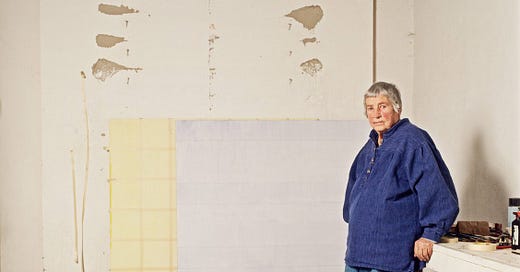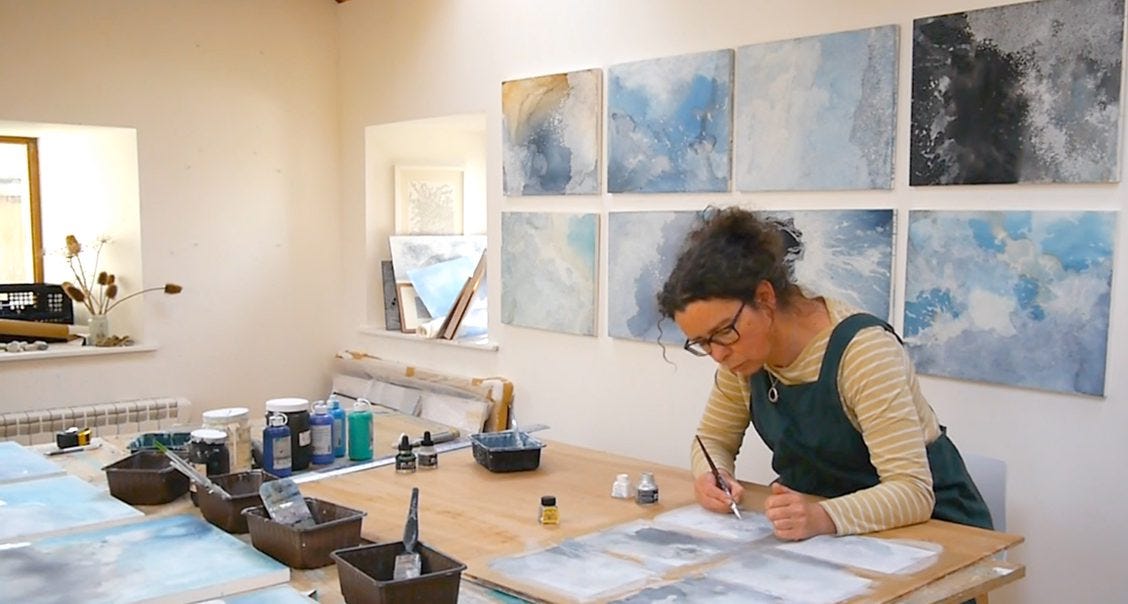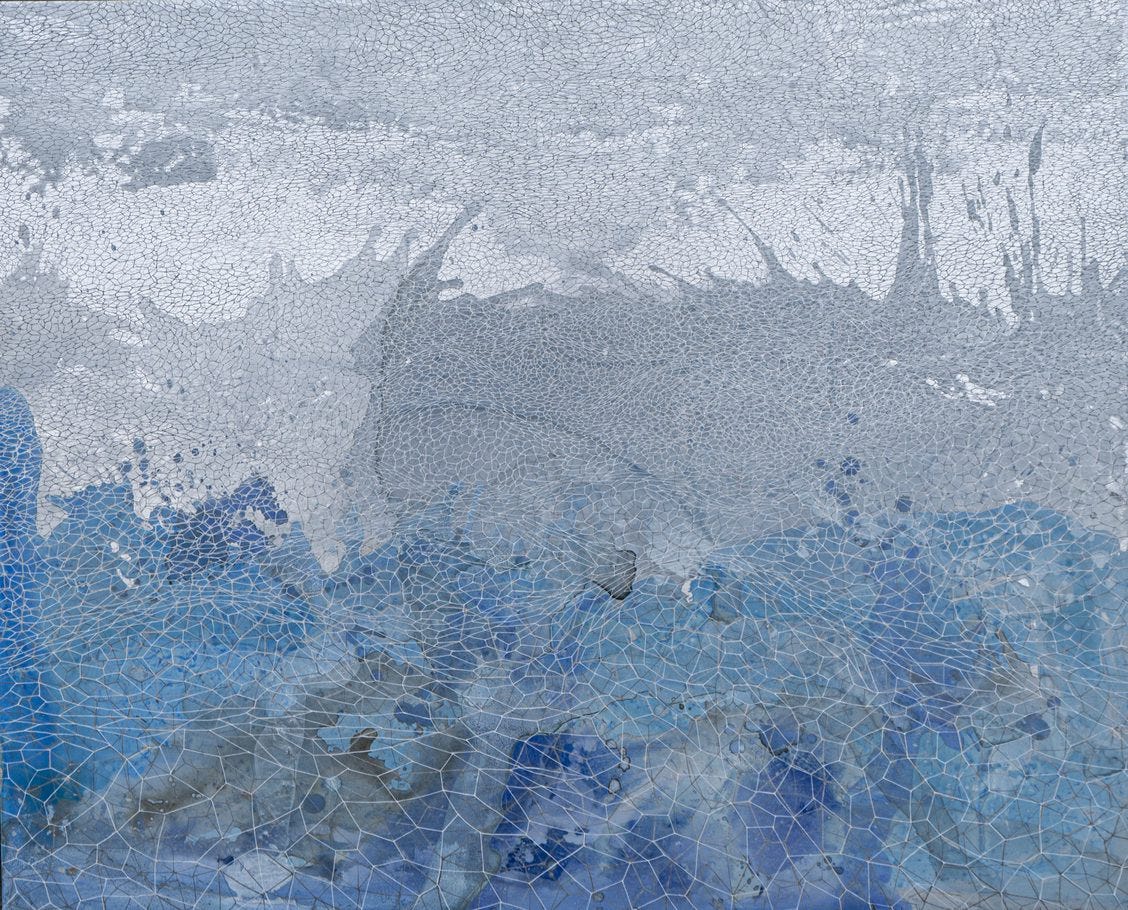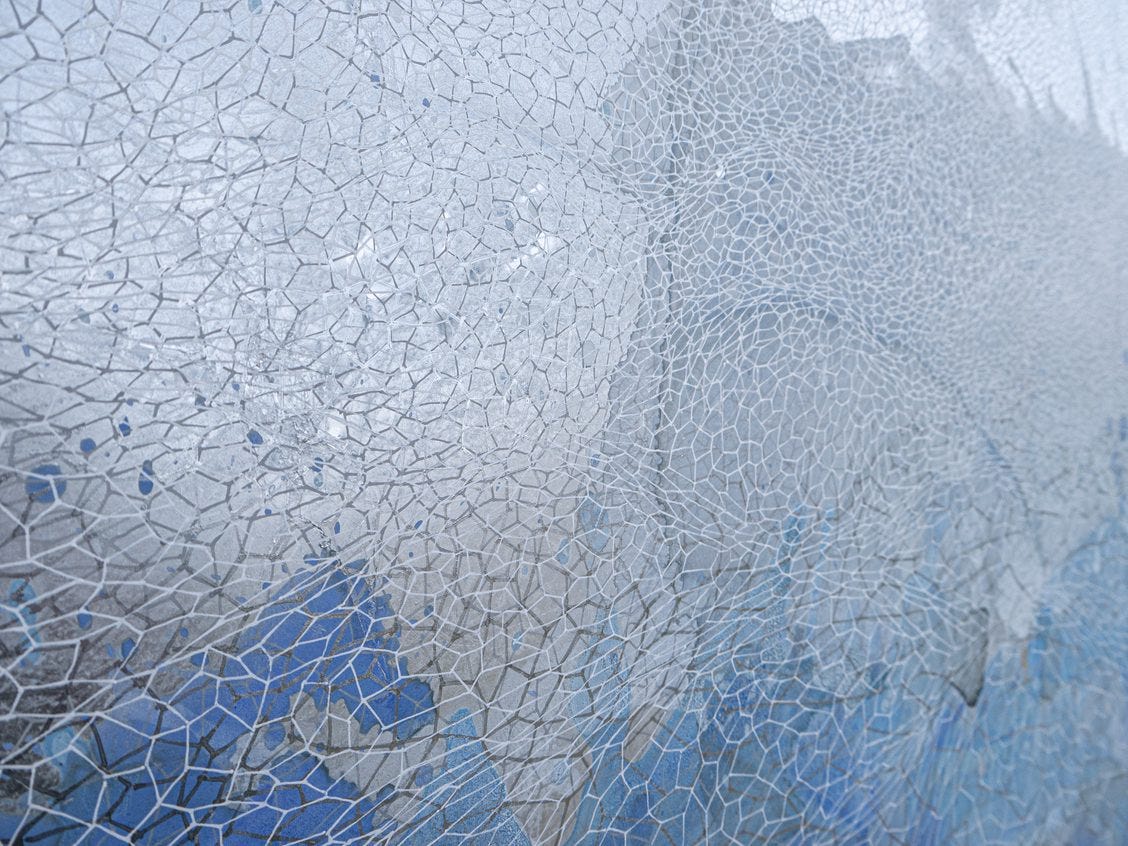If you’ve read my book The Clearing you’ll know I’m a big fan of the artist Agnes Martin. I’ve been thinking about her work and life a lot recently. When the world is falling to bits and it feels ridiculous to spend my time drawing pictures I remind myself of what great art has brought to my life.
Agnes Martin’s paintings have moved me, calmed me, brought me joy and helped me to live. The example of her work makes me want to get cracking in the studio and fires me up with the ‘inspiration’ she wrote so much about. I want to be like her, work like her, bring something value to the world, as she did.
It’s a deep aspiration of mine to ‘be more Agnes’.
Agnes Martin in her studio actually being Agnes
Now, let me just be clear that I know very well that I’m a very, very, very, very long way from achieving this lofty aim. But I hold her work, and the memory of my direct encounters with it, as a kind of beacon, a hope, an inspiration of what art can be and do, a reminder that something as seemingly simple as a picture on a wall can be so much more than just a bit of interior decoration.
I think any really good art, the art that stays with us, whether it’s a book or a painting or a poem or a film or a piece of music, pulls us out of the trance of everydayness that keeps us preoccupied with trivialities so much of the time. Art bumps us out of those tramlines for a moment and takes us somewhere else, somewhere deeper. For a few moments we become a more attentive, more sensitively alive, more empathic version of ourselves. Art reminds us who and what we really are, or could be. It’s an invitation to deepen.
It’s a tall order, to ‘be more Agnes’. Creative work is full of traps and pratfalls. We set off full of hope, inspired by and aspiring to great art. Most of us fail, most of the time. Most of us are not, and never will be, Agnes, or Tolstoy, or [insert your own art hero here]. We are just our flawed and failing selves.
Me, in my studio, not being Agnes.
I’ve been working pretty intensively towards an upcoming exhibition at the RSA and I’m on the home strait now. I’m an old enough hand at this game to know that it’s generally round about now that all the hopes and aspirations I set off with start to drain away along with the adrenalin that kept me going. Along come all those wan and self-pitying thoughts of Is that it? Is that the best I can manage? After all that effort?
This is the flip-side of being inspired by great art. When we are confronted by the results of our own efforts and discover, inevitably, just how far they fall short, the ego takes a bit of a hammering and throws a wobbly.
So how do we live with that? How do we keep going when we know the reality of the work we actually produce is prosaic and mediocre compared to the art heroes who inspired us? Isn’t this a recipe for discouragement?
It can be if we let it.
Also not Agnes….“Immerse” 2022, Samantha Clark, Acrylic, gouache and aluminium leaf on panel, 90 cm x 110 cm
Tibetan Buddhists have an aspiration that’s expressed in a vow – the Bodhisattva Vow – to save all sentient beings in the vastness of space and time from all suffering. It’s a completely, impossibly, ridiculously ambitious aspiration. Mind bogglingly so.
It begs the question, what does it mean to have an aspiration so vast that you cannot possibly hope to fulfil it?
Zen teacher Tataku Pat Phelan says “when we take these vows an intention is created, the seed of an effort to follow through. Because these vows are so vast, they are…..immeasurable. The intention aroused, the effort we cultivate when we call forth these vows, extends us beyond the limits of our personal identities.”
Chogyam Trungpa said that the Bodhisattva vow offers “an expansion of perspective.” It stretches us towards a “bigness of mind” beyond our own ego, its insatiable need to achieve, acquire, attain, and its bottomless hunger for praise, admiration and reward.
The lofty aspiration to make great art is not quite as immense as the Bodhisattva vow, but it’s just as unachievably ambitious for most of us and I think it can function in a similar way, if we let it. To aspire to make truly great art that helps people to live, knowing we won’t ever fully achieve it, is an aspiration that takes us beyond our ego. We set off in full knowledge that we’ll never ‘achieve’ or ‘win’ or ‘hit’ those goals.
It’s like sailing to the horizon. You’ll never ‘arrive’. And that’s OK.
And instead of beating ourselves up about not being as accomplished as we wish we were, we just acknowledge where we’ve got to now, set our compass once again, and keep going.
Ironically, that’s probably exactly what Agnes Martin did…
Sam









Quite thought provoking, Samantha. I confess some bias as I regularly search for The Life Boat posts and comment as an appreciative follower. Your essay and images of your nearly completed painting had a “point-counterpoint” quality. The essay, at first, proposing you fall short of the “Agnes” standard, then the images of your own art saying, “This is Samantha Clark,” was not wobbly in my estimation. Your referring to the Buddhist practice of “Bodhisattva” to describe “Be More Agnes” was an astute choice. There’s considerable separation between striving for perfection and claiming that one’s work is perfect. Delightful and enlightening come to mind, Samantha.